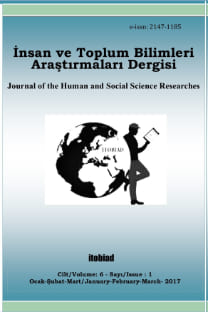Türkiye’nin Canlı Hayvan, Et ve Deniz Ürünleri İhracatındaki Rekabet Gücünün Analizi
: İhracat Rekabet Gücü, Canlı Hayvan, Et, Deniz Ürünleri, Türkiye
Analysis of Turkey’s Competitiveness in Live Animals, Meat and Seafood Exports
Export Competitiveness, Live Animals, Meat, Seafoods, Turkey,
___
- Balassa, B. (1965). Trade Liberalization and Revealed Comparative Advantage, The Manchester School of Economic and Social Studies, 33(2).
- Banterle, A. (2005). Competitiveness and Agri-Food Trade:An Empirical Analysis in The European Union, 11.Congress of European Association of Agricultural Economists (EAAE)-The Future of Rural Europe in The Global Agri-Food System , Cophenagen, Denmark’den;
- Beningo, S. (2005). Trade and Transportation Between the United States and China,and Between the United States and India, 2006 Conference of the Society of Government Economists , Washington.
- Coxhead, I. (2007). A New Resource Curse?Impacts of China’s Boom on Comparative Advantage and Resource Dependence in Southeast Asia, World Development, 35(7).
- Cutrini, E. (2005). The Balassa İndeks Meets the Theil Index: A Decomposition Methodology for Logation Studies
- http://www.ersa.org/ersaconfs/ersa05/papers/123.pdf (Erişim arihi:11.01.2008).
- De Rosa, Dean A. (1996). Agricultural Trade and Rural Development in The Middle East and North Africa-Recent Developments and Prospects, Fourth Annual World Bank Conference on Environmentally Sustainable Development on ‘Rural Well-Being: From Vision to Action’, Washington.
- Erkan, B., Et al. (2015). Türkiye’nin Sebze İhracatında Karşılaştırmalı Üstünlükleri, KSÜ Doğa Bil. Derg., 18(4).
- Havrila, I., Guanawarda, P. (2003). Analysing Comparative Advantage and Competitiveness:An Application to Australian’s Textile and Clothing Industries, Australian Economic Papers, 42(1).
- Hinloopen, J., Et al. (2004). P-P plots and the Harmonic Mass indeks:an application to comparative advantage, 30 July 2004 Seminar at the University of Adelaide, Australia.
- Hinloopen, J.,Et al. (2001). On the empirical distribution of the Balassa Index, Review of World Economics, 137(1).
- Chang, C. (1999). A Partial Equilibrium Analysis on the Effects of Trade Liberalization in APEC Food Sector, APEC Study Centre Consortium-1999 Conference, The APEC Food System and its Implications, Auckland.
- Küçükkiremitçi, O. (2006). Sanayi Sektörünün Dış Ticaret Performansının Rekabet Gücüne Göre Değerlendirilmesi (1995-2005 Dönemi). Ulusal Bağımsızlık İçin Türkiye İktisat Politikaları Kurultayı, Malatya.
- Langhammer, R. (2006). Revealed Comparative Advantages in Service Trade of the USA,EU,and Japan.What Do They Tell Us?,
- http://opus.zbw-kiel.de/volltexte/2006/4005/pdf/langhammer_advantages.pdf (Erişim Tarihi:22.01.2008).
- Lederman, D. (2006). Latin America’s Trade Specialization and China and India’s Growth,
- http://siteresources.worldbank.org/INTLACOFFICEOFCE/Resources/LACspecializationpattern.pdf (Erişim Tarihi:13.12.2008).
- Mahmood, A. (2000). Export Specialization and Competitiveness of the Malaysian Manufacturing: Trends,Challenges and Prospects, Conference on International Trade Education and Research (CITER5)-Managing Globalisation for Prosperity, Melbourne.
- Mykhnenko, V. (2005). What Type of Capitalism in Eastern Europe?Institutional Structures,Revealed Comparative Advantages,and Performance of Poland and Ukraine, Centre for Public Policy for Regions (CPPR) Discussion Paper, 6.
- Pitts, E-Lagnevik, M. What Determines Food Industry Competitiveness? In W.B. Traill and E. Pitts (eds)”, Competitiveness in The Food Industry, Blackie Academic&ProfessionaL.
- Porter, M. (1991). Towards a Dynamic Theory of Strategy. Strategic Management Journal 12.
- Saxena, S.B. ve Lozac’h, V.S. (2010). Competitiveness in the Garment and Textile Industry: Creating a Supportive Environment: A Case Study of Bangladesh. The Asian Foundation, Occasional Paper No:1.
- Utkulu, U. (2005). Türkiye’ nin Dış Ticareti ve Değişen Mukayeseli Üstünlükler, Dokuz Eylül Üniversitesi Yayınları, İzmir.
- Vollrath, T.L. (1991). A Theoretical Evaluation of Alternative Trade Intensity Measures of Revealed Comparative Advantage, Weltwirtschaftliches Archiv, 130.
- Widgren, M. (2006). Challenges Created by the New EU Member States and Third Countries, Prime Minister’s Office Economic Council of Finland, Finland.
- Yılmaz, B., Et al. (2003). The Foreign Trade Pattern and Foreign Trade Specialization of Candidates of The European Union, Ezoneplus Working Paper, Fifth Framework Programme-European Commission, 19.
- http://comtrade.un.org/db/dqBasicQuery.aspx (Erişim Tarihi:13.07.2016).
- ISSN: 2147-1185
- Yayın Aralığı: 4
- Başlangıç: 2012
- Yayıncı: Mustafa SÜLEYMAN ÖZCAN
FATİH CEYLAN, OSMAN TÜZÜN, RAMAZAN EKİNCİ, HAKAN KAHYAOĞLU
Benford Kanunu’nun Vergi Denetiminde Kullanımı ve Bir Örnek Uygulama
HARUN BÜBER, FAZLI YILDIZ, GÖKSEL KARAŞ
Orta Gelir Tuzağını Önlemede Vergi Politikalarının Rolü
GÜL KAYALIDERE, PELİN MASTAR ÖZCAN, UMUT TEPEKULE
Günümüz Koşullarında Bağımsız Devletler Topluluğu Ülkelerinde Ekonomik Entegrasyon
Ramiz TEYUBOGLU (TEYUBOV), TAHİRE HÜSEYİNLİ
OZAN BÜYÜKYILMAZ, SERTAÇ ERCAN, MEHMET GÖKERİK
Yayın İlkeleri ve Kaynakça Gösterimi
Türkiye'nin Canlı Hayvan, Et ve Deniz Ürünleri İhracatındaki Rekabet Gücünün Analizi
